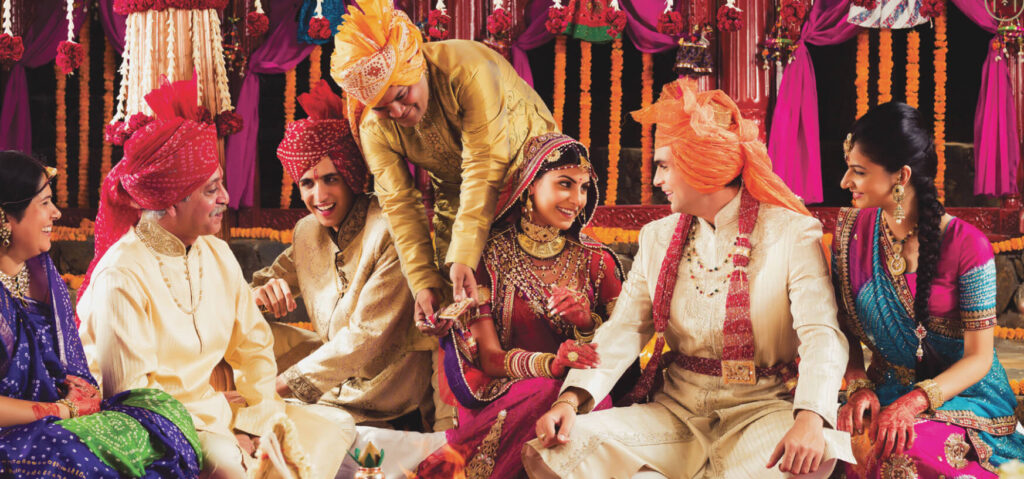Rajasthan, the land of kings, has long been known for its magnificent royal weddings, where tradition, opulence, and grandeur blend seamlessly. These weddings are not just ceremonies but grand spectacles that reflect Rajasthan’s rich heritage. The rituals, lavish décor, and regal attire make them timeless celebrations of love and tradition.

1. Pre-Wedding Rituals: A Sacred Beginning
Roka and Tilak Ceremony
The Roka ceremony marks the formal alliance between two royal families, signifying the beginning of wedding preparations. The groom’s family visits the bride’s palace, offering gifts, jewelry, and blessings.
The Tilak ceremony follows, where the bride’s father applies kumkum (vermilion) on the groom’s forehead, officially welcoming him into the family. This ritual often includes an exchange of swords and royal insignia, symbolizing strength and honor.
Ganesh Puja and Pithi Dastoor
Before the wedding, the Ganesh Puja is performed to seek blessings for a prosperous married life. The Pithi Dastoor, a turmeric ceremony, enhances the bride and groom’s glow, reflecting the traditional beauty practices of Rajasthan’s royalty.
2. The Grand Wedding Procession: Baraat with Royal Splendor
The Baraat (wedding procession) in a royal Rajasthani wedding is nothing short of a regal parade. The groom, dressed in a heavily embroidered sherwani and adorned with pearls and gemstones, arrives at the bride’s palace riding an ornate elephant or a Marwari horse. Accompanied by traditional folk musicians, decorated camels, and torchbearers, the procession creates a mesmerizing spectacle.
At the palace gates, the bride’s family welcomes the groom with the Aarti ritual, where they wave a lit lamp in his honor before he enters.
3. The Royal Wedding Ceremony: Sacred Vows in a Majestic Setting
The main wedding ceremony takes place in grand courtyards, palace gardens, or temple complexes adorned with intricate floral arrangements, golden drapes, and chandeliers. The bride, dressed in a stunning Rajputi Poshak (traditional royal attire) with gold and Kundan jewelry, walks gracefully towards the mandap (sacred wedding altar).
Key Rituals in the Ceremony
- Jaimala (Exchange of Garlands): The bride and groom exchange flower garlands, symbolizing mutual acceptance.
- Pheras Around the Sacred Fire: The couple takes seven vows around the sacred fire, promising love, loyalty, and prosperity.
- Sindoor and Mangalsutra Ceremony: The groom applies sindoor (vermilion) on the bride’s forehead and ties a mangalsutra, signifying their eternal bond.
4. Post-Wedding Traditions: Celebrations and Farewell
Bidai – The Bride’s Grand Farewell
The Bidai ceremony marks the bride’s departure from her paternal home. The farewell, often emotional, involves the bride throwing rice grains behind her, symbolizing gratitude for her upbringing. She then leaves for her new home in a royal palanquin or a decorated chariot.
Royal Reception and Festivities
The groom’s family hosts a grand reception featuring Rajasthani folk music, Ghoomar dance performances, and an extravagant feast with royal delicacies like Dal Baati Churma, Laal Maas, and Ghewar.
5. Royal Wedding Venues in Rajasthan: A Timeless Legacy
Even today, Rajasthan’s palaces and heritage properties host extravagant weddings that mirror the grandeur of past royal ceremonies. Some of the most famous venues include:
- City Palace, Jaipur – A regal venue with breathtaking courtyards.
- Umaid Bhawan Palace, Jodhpur – Known for its opulence and heritage charm.
- Lake Palace, Udaipur – A floating palace that creates a magical wedding setting.
Conclusion
Rajasthan’s royal weddings are a perfect blend of age-old traditions, opulence, and timeless beauty. Every ceremony, from the pre-wedding rituals to the grand reception, reflects the elegance and cultural richness of Rajasthan’s regal past. Even today, these traditions inspire luxury weddings across the world, keeping the legacy of Rajasthan’s royal heritage alive.






